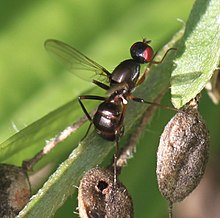Nemopoda nitidula
| Nemopoda nitidula | ||||||||||||
|---|---|---|---|---|---|---|---|---|---|---|---|---|

Nemopoda nitidula |
||||||||||||
| Systematics | ||||||||||||
|
||||||||||||
| Scientific name | ||||||||||||
| Nemopoda nitidula | ||||||||||||
| ( Fallén , 1820) |
Nemopoda nitidula is a species from the family of rocking flies (Sepsidae). The species wasfirst describedin 1820 by Carl Fredrik Fallén as Musca nitidula .
features
The flies reach a body size of about 4.5 mm. The fly species uses mimicry to camouflage itself from enemies . The flies look a lot like ants . The shiny black flies have bright dark red eyes. Two brownish-red longitudinal welts run across the front . The antennae are yellow-brown. The mesopleural bristles are well developed. The tergites have yellow-brown rear margins. The front legs are usually completely yellow-brown. The middle femora are yellow-brown at the base, otherwise black. The middle tibiae are dark at the base, otherwise yellow-brown. The posterior femora are yellow-brown at the base and apical end, otherwise black. The posterior tibiae are dark. The anterior femora of the males have a series of 10–12 long spines on the underside. In addition, their posterior trochanters have two strong thorns on the inside. The transparent wings do not have a wing mark .
distribution
Nemopoda nitidula has a Holarctic distribution. The species is widespread in Europe. In Asia, their occurrence extends to Central Asia and in the east to Japan. In the Nearctic (North America) it occurs on the east coast from Newfoundland to Virginia, in the Midwest from Ontario to Wisconsin and Illinois, and on the west coast in British Columbia, Washington and Alberta. Furthermore, the species is represented in the Afrotropis , there in the Democratic Republic of the Congo .
Way of life
The flies can be seen from April to September. They colonize different habitats and feed on honeydew and nectar . The fly larvae develop in the droppings and dung. But they can also be found in detritus (broken down organic matter in the soil) or in the fruiting body of mushrooms .
meaning
In forensics, Nemopoda nitidula, along with other dipers, can provide important information.
Individual evidence
- ↑ a b c Nemopoda nitidula in Fauna Europaea. Retrieved October 19, 2019
- ↑ a b c d Nemopoda nitidula . www.naturespot.org.uk. Retrieved October 19, 2019.
- ↑ a b Nemopoda nitidula . Sepsidnet. Retrieved October 19, 2019.
- ↑ Species Nemopoda nitidula . bugguide.net. Retrieved October 19, 2019.
- ↑ http://onlinelibrary.wiley.com/doi/10.1111/j.1365-2915.2012.01031.x/abstract
- ↑ http://www.ingentaconnect.com/content/bsc/mve/2012/00000026/00000004/art00007
Web links
- Nemopoda nitidula at www.biolib.cz
- Nemopoda nitidula at www.naturspaziergang.de
- Nemopoda nitidula aramel.free.fr
Video clips
- https://www.youtube.com/watch?v=Q7b6M9ilCYQ - Nemopoda nitidula (Sepsidae)
- https://www.youtube.com/watch?v=Z1eWftJrU2M - Themira + Nemopoda


